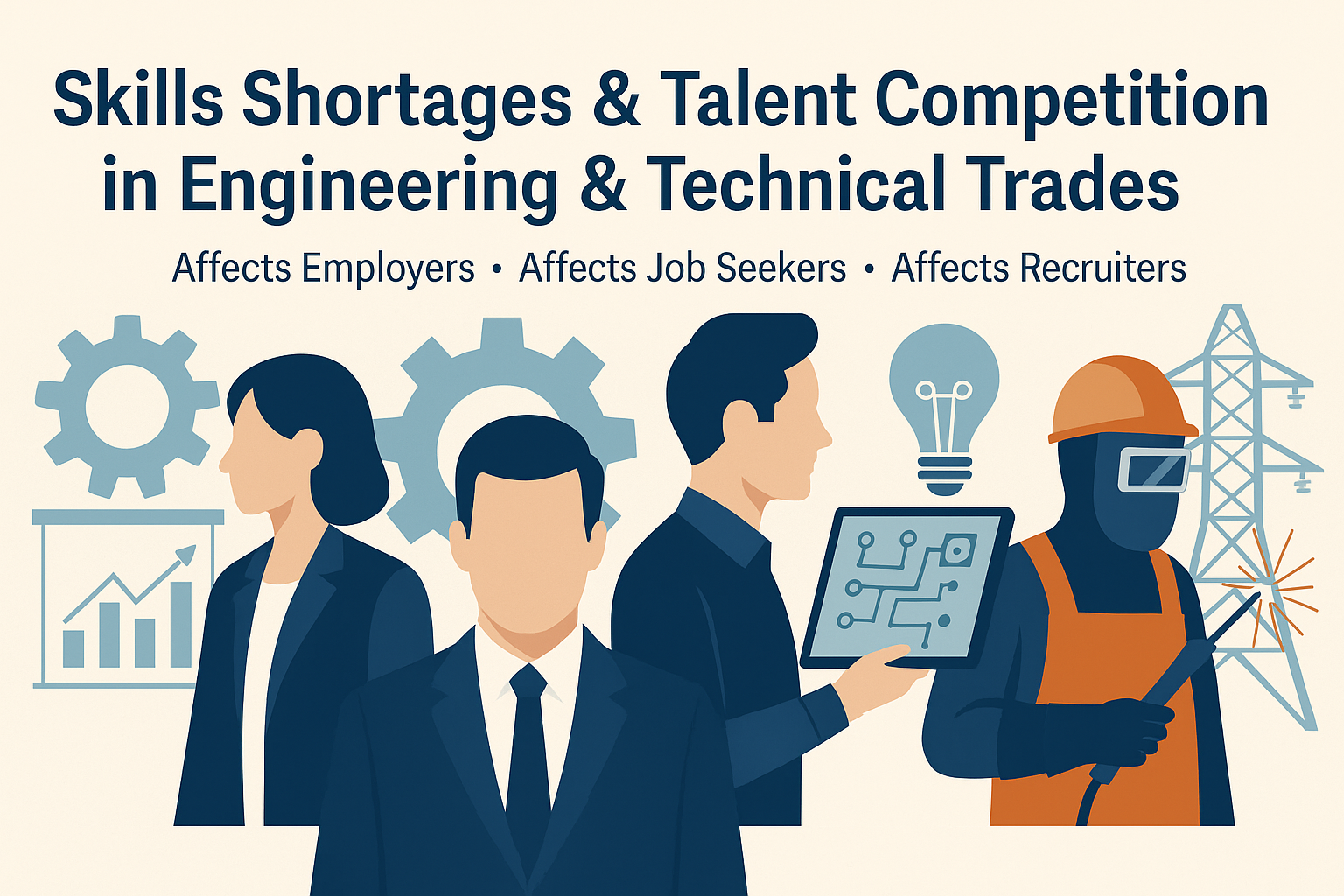In 2025, both engineering and technical trades are under acute pressure from persistent skills shortages and intensifying competition for talent. From welders and electricians to robotics engineers and data analysts, industries are struggling to fill roles critical for infrastructure, energy, manufacturing, and technology innovation.
Employers face rising costs and project delays, job seekers are pressured to keep pace with evolving demands, and recruiters are tasked with bridging one of the toughest hiring landscapes in decades.
The State of the Skills Shortage in Engineering & Technical Trades
The talent crunch extends beyond engineers in high-tech roles. Skilled trades—such as electricians, welders, machinists, HVAC technicians, and industrial mechanics—are also in short supply. These jobs form the backbone of industrial and infrastructure projects, yet many remain unfilled.
Key Drivers:
- Retirement wave: Baby boomers leaving the workforce without enough replacements.
- Declining interest: Fewer young people enter trades due to cultural emphasis on four-year degrees.
- Technology shift: Trades increasingly require digital literacy and specialized technical knowledge.
- Education gap: Apprenticeship and vocational programs haven’t kept pace with demand.
- Sector overlap: Technical trades now compete with advanced engineering and automation roles for talent.
Impact on Employers
- Engineering roles: Companies pay premium salaries and bonuses for scarce specialists, often delaying projects.
- Trade roles: Shortages of electricians, welders, and machinists threaten construction, manufacturing, and energy production schedules.
- Cross-industry competition: Employers across automotive, defense, IT, and utilities are hiring from the same limited pool.
- Increased reliance on contractors: Many employers turn to staffing firms or overseas labor for both engineers and tradespeople.
Impact on Job Seekers
- Engineers with hybrid skills (AI, robotics, clean energy) command top offers.
- Trades professionals’ benefit from strong job security, high wages, and multiple offers—but face rising expectations for tech skills.
- Upskilling pressure: Both groups must adapt to new tools, digital systems, and interdisciplinary teamwork.
- Branding opportunity: Portfolios, certifications, and demonstrable skills set candidates apart.
Impact on Recruiters – Recruiters face parallel challenges across engineering and trades
- Smaller talent pools: Both require active outreach into vocational schools, apprenticeships, and nontraditional programs.
- Shift toward competency-based hiring: Portfolios, certifications, and practical tests matter more than formal degrees.
- Greater advisory role: Recruiters help companies design career paths, competitive packages, and retention strategies for both engineers and trades professionals.
- Technology use: AI and analytics tools help identify transferable skills across trades and engineering disciplines.
Strategies for Moving Forward
Employers should:
- Develop apprenticeship and internship programs for trades alongside engineering graduate pipelines.
- Invest in continuous training to upskill existing staff.
- Offer flexible schedules, competitive pay, and long-term career paths to attract younger workers.
Job seekers should:
- Embrace lifelong learning, whether through certifications, new technologies, or hands-on projects.
- Showcase both technical and soft skills—adaptability, communication, and leadership matter.
- Evaluate employers for career growth and training support.
Recruiters should:
- Build partnerships with trade schools, unions, and vocational training programs.
- Promote skill-based hiring to widen candidate pools.
- Streamline hiring processes to capture top candidates before they accept competing offers.
Conclusion
The skills shortage spans from engineers designing advanced robotics to tradespeople wiring new infrastructure. While the pressures differ, the core issue is the same: demand outpaces supply.
Employers, recruiters, and workers who embrace training, flexibility, and long-term career strategies will thrive in this competitive environment. Those who treat talent as a renewable resource to be built—not just bought—will gain lasting advantage.
Sources
- Inside Higher Ed (Sept 2025) – “New Report Warns of Skills Shortages”
- RS Components – “The Engineering Talent Shortage”
- Engineering & Technology Jobs (2025) – Employment Outlook for Engineers
- ACSCM – “Solving the Engineering Talent Shortage”
- RoboDK Training Academy (2024) – Addressing Robotics Skills Shortage
- Stonehaven Global – “Engineering Skills Gap”
- The Australian – “Jobs and Skills Australia Calls for Blended Degrees”
- Boston Consulting Group (2023) – “Addressing the Engineering Talent Shortage”
- Hirecruiting (2025) – “Strategies for Employers in Talent Shortages”
- Select Software Reviews – “Recruiting Statistics”
- ArXiv – Studies on Skills Gaps in Engineering Education
- TalentMSH – “Hiring & Recruiting Trends”

